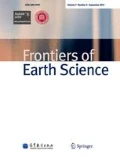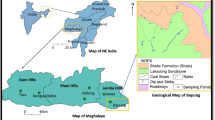Abstract
Although various coaly source rocks widely developed in the Carboniferous-Permian (C-P) of the Bohai Bay Basin, their geochemical characteristics and hydrocarbon generation potential are poorly understood. This study aims to discriminate the contribution of hydrocarbon generation from different C-P coaly source rocks and clarify the differences within generated oils using organic geochemistry, organic petrology, and thermal simulation experiments. The coaly source rocks containt coal clarain and durain, carbonaceous shale, and shale deposited in deltaic and lagoonal environment. The results indicated that clarain, durain, and carbonaceous shale exhibited higher hydrogen index and liquid-gas hydrocarbon yields than lagoonal and deltaic shales, which was mainly associated with the concentrations of sporinite, cutinite, and hydrogen-rich collodetrinite. Aliphatic hydrocarbons originated from coal and carbonaceous shale presented lower Ts/(Ts + Tm), Gα/17α(H)21β(H)-C30 hopane, 18α(H)-oleanane/17α(H)21β(H)-C30 hopane ratios, and higher 17β(H)21α(H)-C30 Morane/17α(H)21β (H)-C30 hopane than deltaic lagoonal shales. Parameters of aromatic hydrocarbons generated from five lithologies of coaly source rocks trended as clear group distribution, e.g., clarain and durain showing lower MNR, DBT/Fluorene (F) ratios and higher DBF/F ratio than coaly shales. The distinct descending trend of hydrocarbon potential is obtained from clarain, durain, carbonaceous shale to lagoonal and deltaic shales, implying dominated the petroleum and natural gas supplement from coal and carbonaceous shale. The difference between aliphatic and aromatic hydrocarbons provides a significant contribution to analyze the generic relationship between coaly source rock and lacustrine shale. Our results illustrate the importance of coaly source rocks for the in-depth oil-gas exploration of the Bohai Bay Basin and understanding hydrocarbon generation potential of source rocks in coal bearing strata.
Similar content being viewed by others
References
Ahmed M, Volk H, George S C, Faiz M, Stalker L (2009). Generation and expulsion of oils from Permian coals of the Sydney Basin. Australia. Org Geochem, 40(7): 810–831
Asif M (2010). Geochemical applications of polycyclic aromatic hydrocarbons in crude oils and sediments from pakistan. Dissertation for Doctor Degree. Lahore: University of Engineering and Technology
Asif M, Alexander R, Fazeelat T, Pierce K (2009). Geosynthesis of dibenzothiophene and alkyl dibenzothiophenes in crude oils and sediments by carbon catalysis. Org Geochem, 40(8): 895–901
Chang J, Qiu N, Zhao X, Shen F, Liu N, Xu W (2018). Mesozoic and Cenozoic tectono-thermal reconstruction of the western Bohai Bay Basin (East China) with implications for hydrocarbon generation and migration. J Asian Earth Sci, 160: 380–395
Collinson M E, Van Bergen P F, Scott A C, De Leeuw J W (1994). The oil-generating potential of plants from coal and coal-bearing strata through time: a review with new evidence from Carboniferous plants. Geol Soc Lond Spec Publ, 77(1): 31–70
Colmenero J R, Suárez-Ruiz I, Fernández-Suárez J, Barba P, Llorens T (2008). Genesis and rank distribution of Upper Carboniferous coal basins in the Cantabrian Mountains, Northern Spain. Int J Coal Geol, 76(3): 187–204
D’Angelo J A, Zodrow E L, Camargo A (2010). Chemometric study of functional groups in Pennsylvanian gymnosperm plant organs (Sydney Coalfield, Canada): implications for chemotaxonomy and assessment of kerogen formation. Org Geochem, 41(12): 1312–1325
Figueiredo J J P, Hodgson D M, Flint S S, Kavanagh J P (2010). Depositional environments and sequence stratigraphy of an exhumed permian mudstone-dominated submarine slope succession, Karoo Basin, South Africa. Am J Bot, 60: 736–744
Greb S F, Martino R L (2005). Fluvial-Estuarine Transitions in Fluvial dominated Successions: Examples from the Lower Pennsylvanian of the Central Appalachian Basin. In: Blum M D, Marriott S B, Leclair S F, eds. Fluvial Sedimentology VII. IAS Special Publication 35: 425–451
Hartgers W A, Sinninghe Damste J S, de Leeuw J W, Ling Y, Dyrkacz G R (1994). Molecular characterization of flash pyrolyzates of two carboniferous coals and their constituting maceral fractions. Energy Fuels, 8(5): 1055–1067
He J, Ding W, Zhang J, Li A, Zhao W, Dai P (2016). Logging identification and characteristic analysis of marine-continental transitional organic-rich shale in the Carboniferous-Permian strata, Bohai Bay Basin. Mar Pet Geol, 70: 273–293
Hughes W B, Holba A G, Dzou L (1995). The ratios of dibenzothiophene to phenanthrene and pristane to phytane as indicators of depositional environment and lithology of petroleum source rocks. Geochim Cosmochim Acta, 59(17): 3581–3598
ICCP (International Committee for Coal and Organic Petrology) (1998). The new vitrinite classification (ICCP System 1994). Fuel, 77(5): 349–358
ICCP (International Committee for Coal and Organic Petrology) (2001). The new inertinite classification (ICCP System 1994). Fuel, 80(4): 459–471
ISO 7404-2 (2009). Methods for the Petrographic Analysis of Bituminous Coal and Anthracite-Part 2: Methods for Preparing Coal Samples. International Organization for Standardization, Geneva, Switzerland, 8
ISO 7404-3 (2009). Methods for the Petrographic Analysis of Coals-Part 3: Method of Determining Maceral Group Composition. International Organization for Standardization, Geneva, Switzerland, 18
ISO 7404-5 (2009). Methods for the Petrographic Analysis of Coals-Part 5: Method of Determining Microscopically the Reflectance of Vitrinite, Geneva, Switzerland, 14
Jin Q, Song G, Wang L (2009). Generation models of Carboniferous-Permian coal-derived gas in Shengli Oilfield. Pet Explor Dev, 36(3): 358–364
Kędzior S (2009). Accumulation of coal-bed methane in the south-west part of the Upper Silesian Coal Basin (southern Poland). Int J Coal Geol, 80(1): 20–34
Kim J (2001). Comparison of the Ordovician-Carboniferous boundary between Korea and NE China: implications for correlation and tectonic evolution. Gondwana Res, 4(1): 39–53
Li J G, Li M, Wang Z Y (2004). Dibenzofuran series in terrestrial source rocks and crude oils and applications to oil-source rock correlations in the Kuche Depression of Tarim Basin, NW China. Chin J Geochem, 23(2): 113–123
Li L, Li Z, Liu H J, Fang X Y (2015). Late Mesozoic to Cenozoic extension and strike slip structures and deep background of Bohai Bay Basin. Chinese Journal of Geology, 50: 446–472
Li M, Wang T, Zhong N, Zhang W, Sadik A, Li H (2013). Ternary diagram of fluorenes, dibenzothiophenes and dibenzofurans: Indicating depositional environment of crude oil source rocks. Energy Exploration & Exploitation, 31(4): 569–588
Li Y, Tang D, Wu P, Niu X, Wang K, Qiao P, Wang Z (2016). Continuous unconventional natural gas accumulations of Carboniferous-Permian coal-bearing strata in the Linxing area, northeastern Ordos basin, China. J Nat Gas Sci Eng, 36: 314–327
Li Y, Wang Z, Gan Q, Niu X, Xu W (2019a). Paleoenvironmental conditions and organic matter accumulation in Upper Paleozoic organic-rich rocks in the east margin of the Ordos Basin, China. Fuel, 252: 172–187
Li Y, Wang Z, Wu P, Gao X, Yu Z, Yu Y, Yang J (2019b). Organic geochemistry of Upper Paleozoic source rocks in the eastern margin of the Ordos Basin, China: input and hydrocarbon generation potential. J Petrol Sci Eng, 181: 106202
Li Y, Yang J, Pan Z, Tong W (2020). Nanoscale pore structure and mechanical property analysis of coal: an insight combining AFM and SEM images. Fuel, 260: 116352
Li Z X, Sun Y Z, Yu J F, Liu D Y (2001). Marine transgression “event” in coal formation from North China Basin. Energ Energ Explor & Exploit, 19(6): 559–567
Liu G (1990). Permo-Carboniferous paleogeography and coal accumulation and their tectonic control in the north and south China continental plates. Int J Coal Geol, 16(1–3): 73–117
Luo J, Cheng K, Fu L (2001). Alkylated dibenzothiophene index: a new method to assess thermal maturity of source rocks. Acta Petrol Sin, 22(3): 27–32
Lv D, Chen J (2014). Depositional environments and sequence stratigraphy of the Late Carboniferous-Early Permian coal-bearing successions (Shandong Province, China): sequence development in an epicontinental basin. J Asian Earth Sci, 79: 16–30
Mello M R, Gaglianone P C, Brassell S C, Maxwell J R (1988). Geochemical and biological marker assessment of depositional environments using Brazilian offshore oils. Mar Pet Geol, 5(3): 205–223
Michelsen J K, Khorasani G K (1990). Monitoring chemical alterations of individual oil-prone macerals by means of microscopical fluorescence spectrometry combined with multivariate data analysis. Org Geochem, 15(2): 179–192
Peters K E, Cassa M R (1994). Applied source rock geochemistry. In: Magoon L B, Dow W G, eds. The Petroleum System-From Source to Trap: AAPG Memoir 60: 93–117
Petersen H I, Andsbjerg J, Bojesen Koefoed J A, Nytoft H P (2000). Coal — generated oil: source rock evaluation and petroleum geo-chemistry of the Lulita oilfield, Danish North Sea. J Pet Geol, 23(1): 55–90
Pickel W, Kus J, Flores D, Kalaitzidis S, Christanis K, Cardott B J, Misz-Kennan M, Rodrigues S, Hentschel A, Hamor-Vido M, Crosdale P, Wagner N (2017). Classification of liptinite- ICCP system 1994. Int J Coal Geol, 169: 40–61
Radke M, Vriend S P, Ramanampisoa L R (2000). Alkyldibenzofurans in terrestrial rocks: influence of organic facies and maturation. Geochim Cosmochim Acta, 64(2): 275–286
Radke M, Willsch H (1994). Extractable alkyldibenzothiophenes in Posidonia Shale (Toarcian) source rocks: relationship of yields to petroleum formation and expulsion. Geochim Cosmochim Acta, 58 (23): 5223–5244
Ryder R T, Jin Q, McCabe P J, Nuccio V F, Persits F (2012). Shahejie-Shahejie/Guantao/Wumishan and Carboniferous/Permian coal-Paleozoic total petroleum systems in the Bohaiwan Basin, China (based on geologic studies for the 2000 World Energy Assessment Project of the US Geological Survey). US Geological Survey, Reston, Virginia
Stasiuk L D (1994). Oil-prone alginite macerals from organic-rich Mesozoic and Palaeozoic strata, Saskatchewan, Canada. Mar Pet Geol, 11(2): 208–217
Suwarna N (2006). Permian Mengkarang coal facies and environment, based on organic petrology study. Indonesian J Geosci, 1: 1–8
Tang X, Zhang J, Shan Y, Xiong J (2012). Upper Paleozoic coal measures and unconventional natural gas systems of the Ordos Basin, China. Geosci Front, 3(6): 863–873
Tewari R C, Khan Z A (2015). Origin of banded structure and coal lithotype cycles in Kargali coal seam of East Bokaro sub-basin, Jharkhand, India: environmental implications. J Earth Syst Sci, 124(3): 643–654
Wang D D, Shao L Y, Li Z X, Li M P, Lv D, Liu H (2016). Hydrocarbon generation characteristics, reserving performance and preservation conditions of continental coal measure shale gas: a case study of Mid-Jurassic shale gas in the Yan’an Formation, Ordos Basin. J Petrol Sci Eng, 145: 609–628
Wei Z B, Zhang D J, Zhang C L, Chen J P (2001). Methyldibenzothiophenes distribution index as a tool for maturity assessments of source rocks. Geochim Cosmochim Acta, 30(3): 242–248
Xu J J, Jin Q (2020). Hydrocarbon potential and polycyclic aromatic compounds differences of Carboniferous-Permian coaly source rocks, Bohai Bay Basin: an implication for different sources of gas condensate and oils. J Petrol Sci Eng, 195: 107899
Zeng L B, Su H, Tang X M, Peng Y M, Gong L (2013). Fractured tight sandstone oil and gas reservoirs: a new play type in the Dongpu depression, Bohai Bay Basin, China. AAPG Bull, 97(3): 363–377
Zhao X, Jin F, Wang Q, Bai G (2015). Buried-hill play, Jizhong subbasin, Bohai Bay basin: a review and future prospectivity. AAPG Bull, 99: 1–26
Zhao X, Zhou L, Pu X, Jiang W, Jin F, Xiao D, Han W, Zhang W, Shi Z, Li Y (2018). Hydrocarbon-generating potential of the Upper Paleozoic section of the Huanghua Depression, Bohai Bay Basin, China. Energy Fuels, 32(12): 12351–12364
Zhou L, Fu L, Lou D, Lu Y, Feng J, Zhou S, Santosh M, Li S (2012). Structural anatomy and dynamics of evolution of the Qikou Sag, Bohai Bay Basin: implications for the destruction of North China craton. J Asian Earth Sci, 47: 94–106
Acknowledgements
The work presented in this paper was supported by the Certificate of National Science and Technology Major Project of the Ministry of Science and Technology of China (No. 2016ZX05006-007-004), National Natural Science Foundation of China (Grant Nos. 41702139, 420772164, 42072130, and U1762217), Natural Science Foundation of Shandong Province (No. ZR2017BD036), the Fundamental Research Funds for the Central Universities (No. 18CX02008A), and Taishan Scholar Program of Shandong Province (No. TSQN201812030). We also thanks for the data support from PetroChina Dagang Oilfield Company.
Author information
Authors and Affiliations
Corresponding author
Rights and permissions
About this article
Cite this article
Xu, J., Lou, D., Jin, Q. et al. Discriminating hydrocarbon generation potential of coaly source rocks and their contribution: a case study from the Upper Paleozoic of Bohai Bay Basin, China. Front. Earth Sci. 15, 876–891 (2021). https://doi.org/10.1007/s11707-021-0908-7
Received:
Accepted:
Published:
Issue Date:
DOI: https://doi.org/10.1007/s11707-021-0908-7




